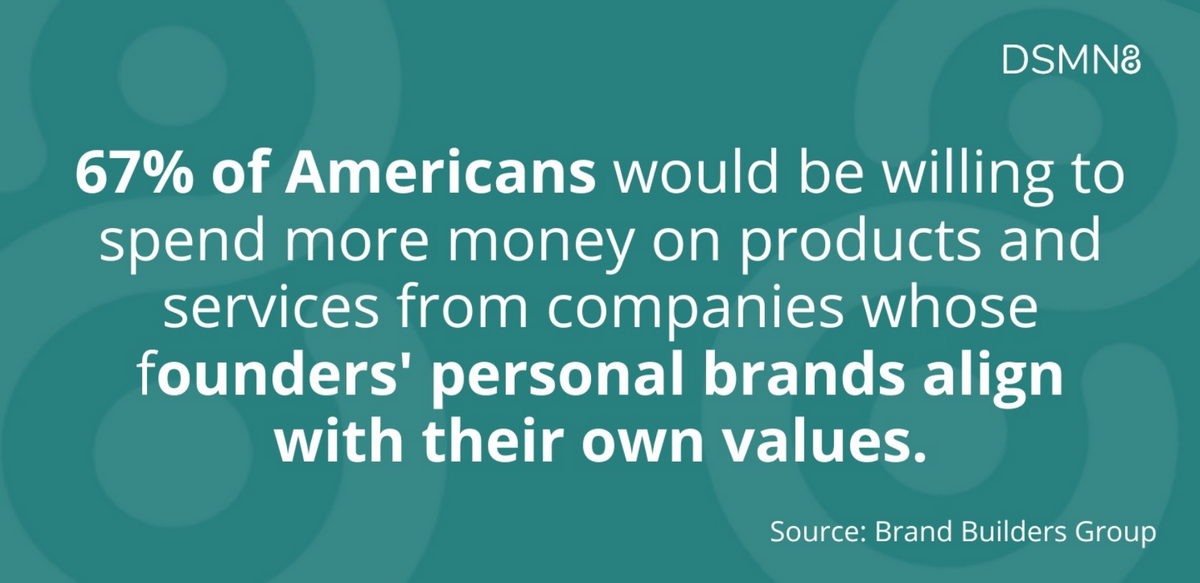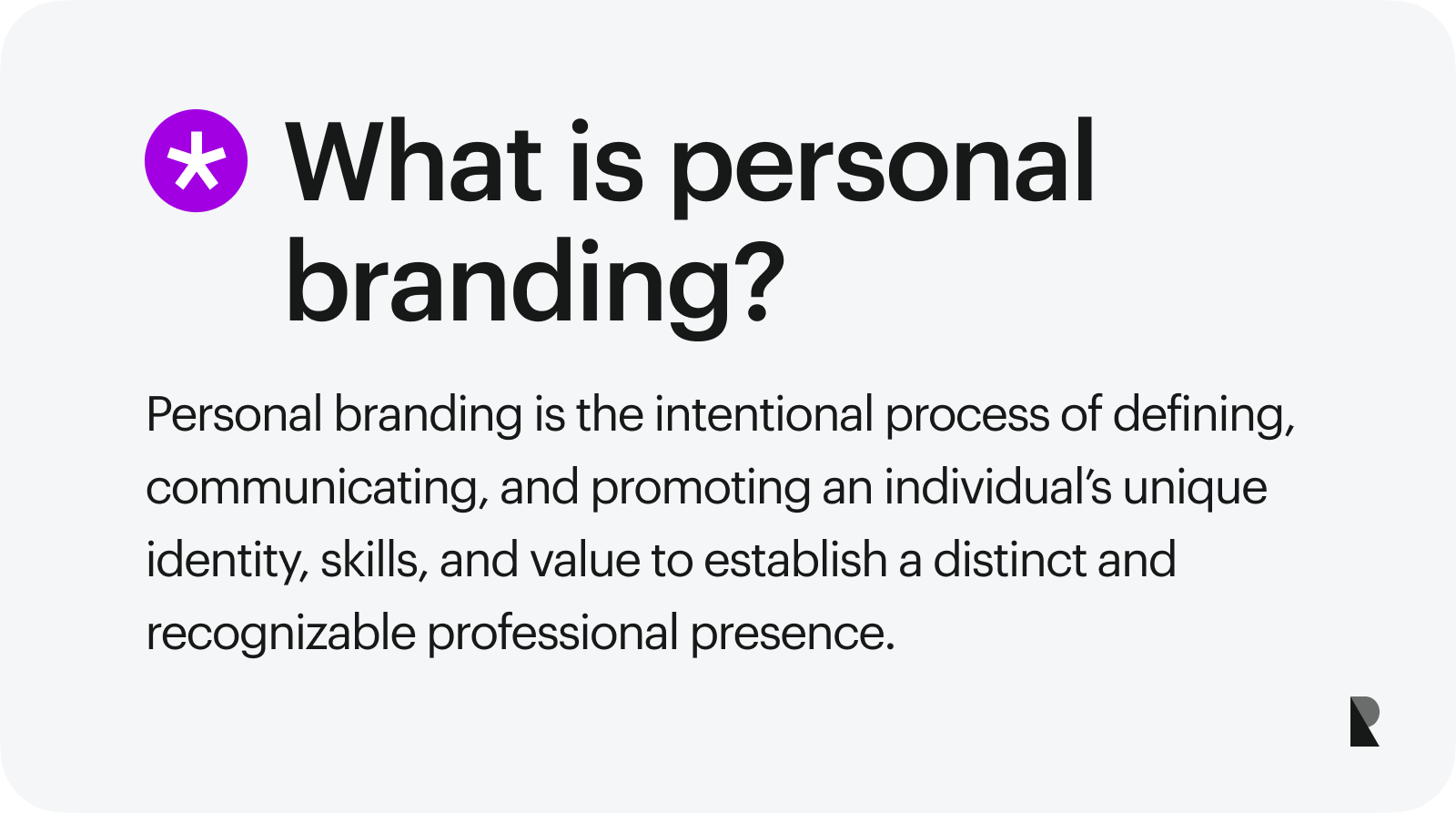
Making a name for yourself could be as important as starting a business. In the modern World, branding no longer works only for corporations, products, and services—it works magic for everyone. Related to personality, branding might easily draw attention, drive engagement, and inspire others into action. The best part is that this personality does not have to be a famous actor, singer, or sports celebrity—it could be you.
The importance of building a personal brand cannot be stressed enough. As people become more concerned about their surroundings' trust, credibility, and authenticity, they should have confidence in the person, whether they seek a partnership or a mentor. Creating your brand, regardless of niche and target audience, might be your ticket to successfully achieving professional and individual goals.
What is personal branding, why is it important, and how can you build one with a professional branding agency? We will address all those questions today.
Defining Personal Branding
Do you know that everyone is a personal brand? Personal branding is your unique identity. It embraces the reputation, values, mission, vision, behavior, and communication style, creating a unified image and underlining the general perception of the individual in the minds of the community.
In marketing and advertising, personal branding goes far beyond these aspects. It is an ongoing process of building a unique public persona on digital and real-world platforms, influencing general perception, and carving a position in the community and market. It is an engaging, meaningful, and memorable narrative highlighting unique personality traits, strengths, and weaknesses reflected in communication and activities.
Personal branding aims to establish industry authority and stand out from the competition. Many tasks are performed, including understanding the individual's archetype and personality, crafting the right visual image, devising authentic strategies and campaigns, targeting the right audience, building trust and authority, and consistently delivering on the promise.
The Benefits of Strong Personal Branding
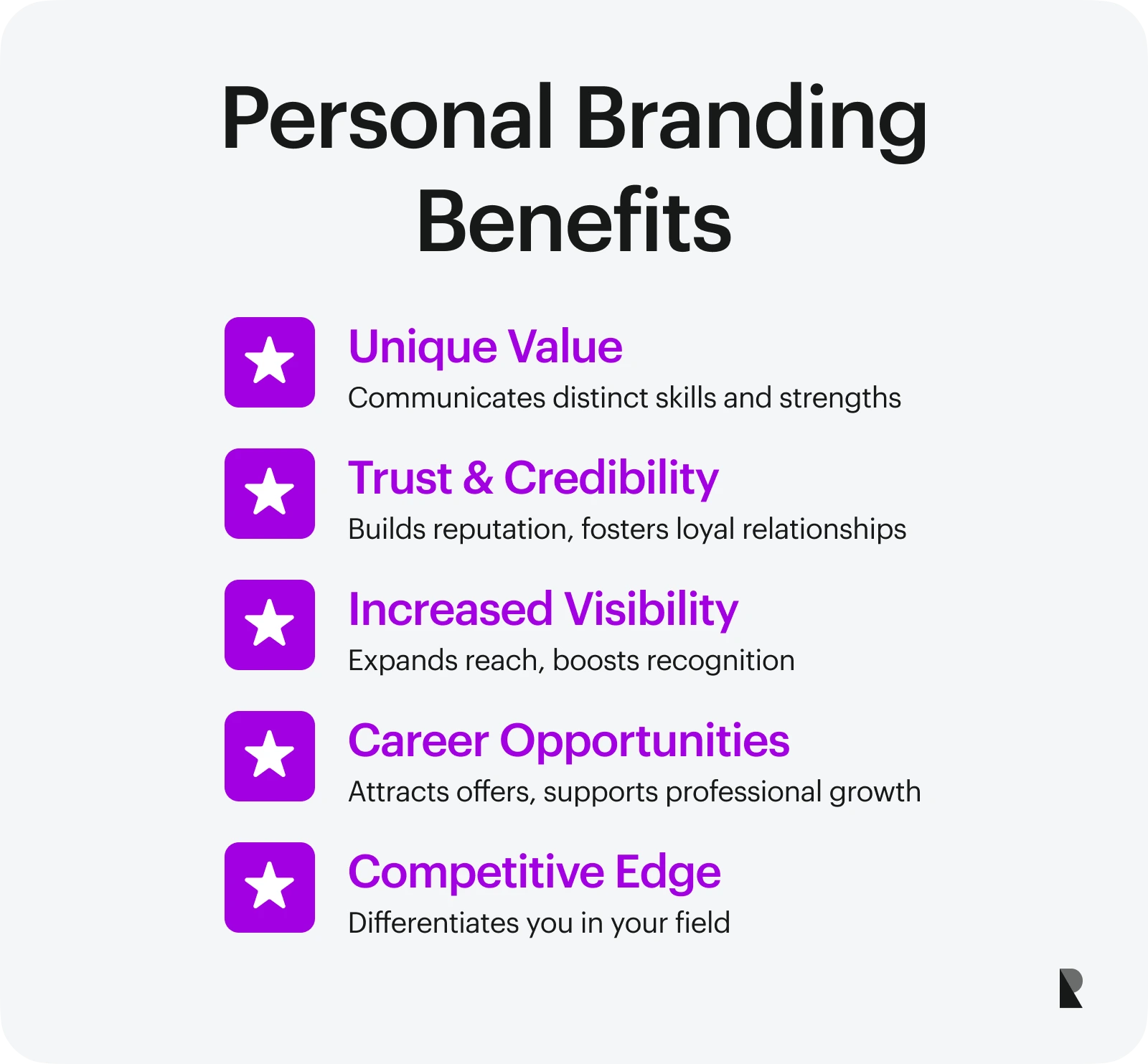
So, why is personal branding important? Even if you are not up to fame and millions of fans on social media, you still benefit from contributing to your public image and reputation. Not only do they make up the story of your past, demonstrating your knowledge and expertise, but they also underlie a positive experience from being in your presence or working with you. Here is how you can benefit from the proper personal branding.
Create a unique value proposition
Strong personal branding is like a strong product. It has a unique value proposition—a mix of economic values that it promises to deliver to customers or, in this particular case, to people with whom the individual interacts. It summarizes knowledge, skills, experience, contributions, stories, and convictions that benefit your work.
Build trust and credibility
Trust and credibility are cornerstones of engagement, collaboration, and productivity. They empower open communication, improved teamwork, and a safe environment in society and the market, resulting in strong customer relationships, high retention rates, and better business outcomes. Building personal branding helps you stand out from the competition and establish yourself as a thought leader in the niche, creating a loyal community.
Increase visibility
Adapting personal branding strategies that, generally, involve marketing and advertising campaigns across social media and the web exposes you to a wider audience, thereby increasing your visibility in the community and making people know and talk about you. This directly impacts awareness, reputation, and overall market share, separating you from the competition, increasing recognition, and reinforcing your position.
Career growth and job offers
Strong personal branding opens golden opportunities for collaboration. Demonstrating your skills, knowledge, experience, value proposition, unique story, and passion in a particular field makes connecting with like-minded people, potential employers, clients, and collaborators easier. It empowers career growth and makes the job-seeking process easier and more productive.
To secure all those benefits, it is essential to hire a professional branding company whose knowledge, experience, and diverse pool of talents allow you to unlock your true potential and capitalize on your identity through customized and highly personalized branding, marketing, and advertising campaigns across multiple interaction points and communication channels.
Core Elements of a Personal Brand
Building strong personal branding is a complex process that relies on perfecting the core elements that demonstrate your unique value, consistently delivering the key message, and connecting with your target audience through authentic means. These essential building blocks are purpose and values, expertise and skills, voice and tone, visual identity, and digital footprint.
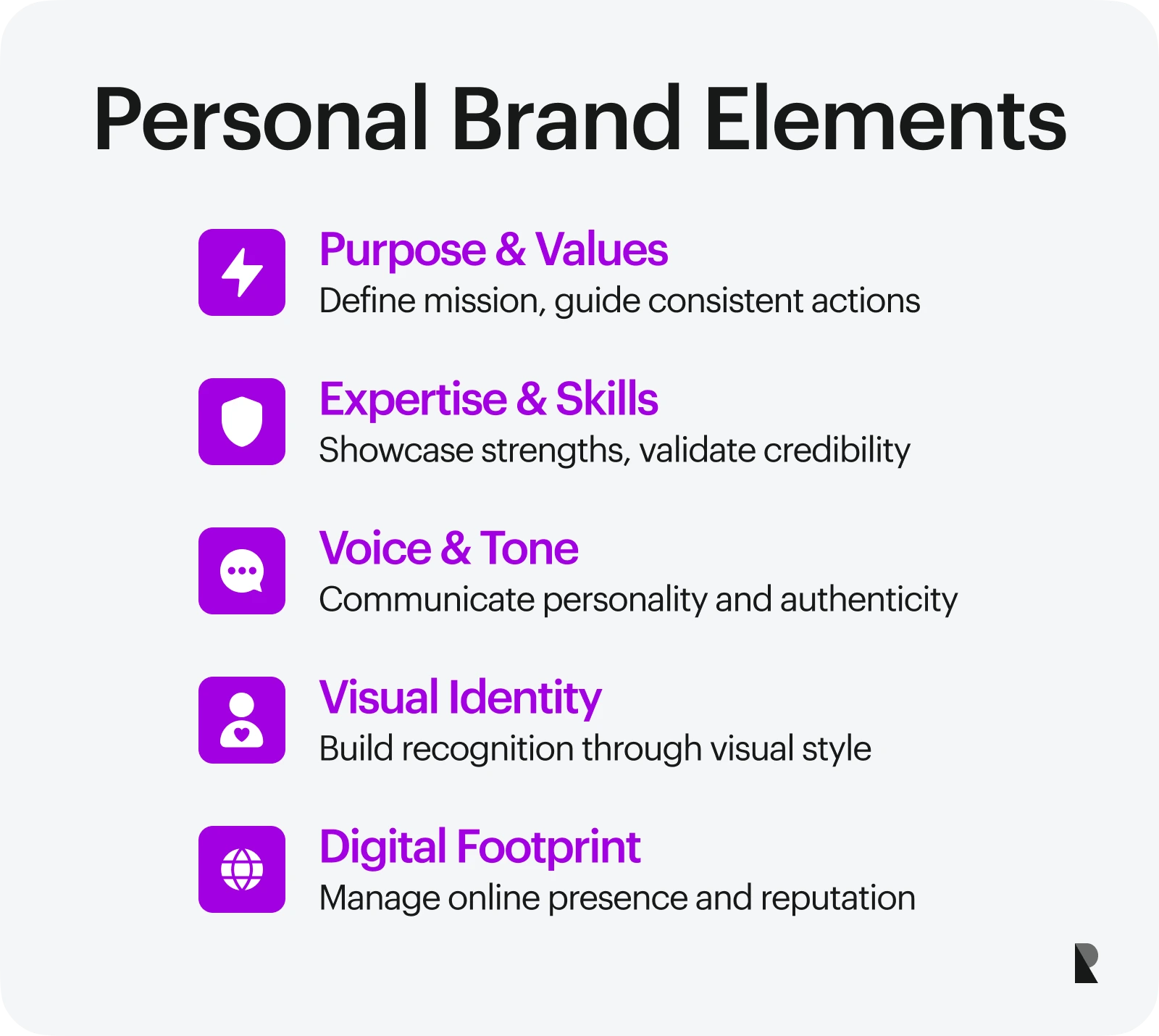
Purpose and values
Purpose is the fundamental element underlying why you want to build your brand in the first place. It creates a sense of meaning and inspires actions and decisions. On the other hand, values are principles that shape your behavior in the channels and make you stick to a coherent image and deliver a consistent message. It provides a solid foundation for operating in the market and community.
These two core elements empower digital marketing and advertising strategists, guide content topics, inspire partnerships, and stand behind audience alignment. Therefore, it is essential to define them right at the beginning, coming up with the right mission and statement.
Expertise and skills
Expertise and skills are two main qualities that prove your validity and the value of collaboration. Consistent professionalism fueled by your knowledge and ever-evolving skills demonstrates your unique personality and distinguishes you from competitors. It gives real reasons for customers to choose you among others or follow your lead.
Therefore, it is essential to highlight your knowledge, skills, and expertise and deliver them clearly and consistently to the audience across various interaction points. To back up your competence, highlight your achievements, accolades, awards, certificates, and other seals of approval.
Voice and tone
Voice and tone are key elements of productive communication and message delivery. They help the audience understand your brand through your message, personality, and emotions. They reflect an individual's authenticity and unique traits and values, fostering trust and loyalty and building a strong connection.
When elaborating on these elements, it is crucial to define your communication style, which should be aligned with values, purpose, and mission. This style should include tone, vocabulary, style, and emotional range. It also helps to create a guideline that ensures consistency across communication channels.
Visual identity
As the saying goes, "We eat with our eyes," making visual identity one of the core elements of successful personal branding. It conveys your message through one of the most memorable and meaningful means of communication, creating associations with the individual on the emotional level and becoming a powerful tool for building perception, reputation, trust, and credibility.
Choosing a visual style requires total commitment and devotion, as it underlies most presentations and communication. Your colors, logotype, mascot, typeface, profile photo, imagery, and videos must perfectly align with your vision and values.
Digital footprint
It is almost impossible to have no digital footprint. We all have one as a result of our activity in the digital landscape (web, social media, email, chat, comments). Therefore, it is crucial to control it as it impacts your reputation, recognition, credibility, authority, and even the way you interact with others.
A well-managed digital footprint ensures you achieve your branding goals and continuous growth and development as a personality. It calls for regular audits to channel your efforts in the right direction and build trust and authority.
How to Build a Personal Brand: Step-by-Step Framework
Building a strong personal brand is a continuous process that requires investments and cooperation with top branding firms. It might take months and years to achieve your ultimate goals. Therefore, before starting the process, it is crucial to understand what it involves step by step.
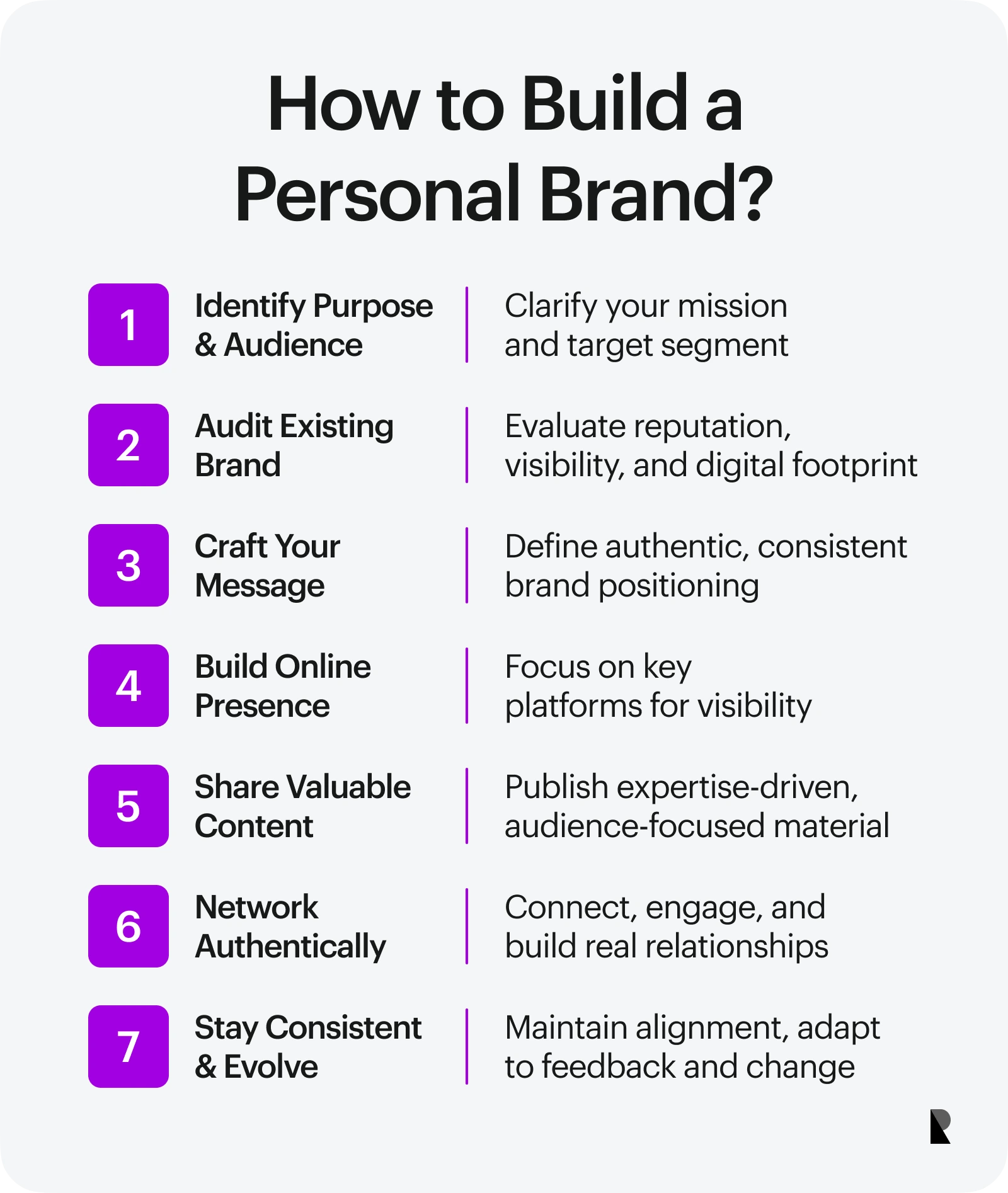
Step 1: identify your purpose and audience
The first step is to establish a solid foundation for your activities across multiple interaction points by identifying two core elements: purpose and audience.
Creating a personal brand is why you do so, whereas the target audience is your market segment with whom you will communicate and collaborate.
Therefore, clarify what makes you special. List values or qualities that separate you from the others. Define who you want to serve or interact with and how you will benefit them. Examine personal brand statement examples in your niche to understand how to deliver your purpose briefly yet meaningfully to the target audience.
Step 2: audit your existing brand
The second step is to evaluate your existing brand. As we are all personal brands at some point, it is crucial to understand what you already have: your reputation, visibility on the web, and perception.
Start by auditing your digital footprint: Google yourself, review social media accounts and activities, and check out bios, LinkedIn, and websites. Use a professional instrument to listen to and inspect the activity. You must have a complete image of your personality and identify gaps and inconsistencies in your presentation and message delivery.
Step 3: craft your message
A personal message is a cornerstone of communication with your fans or customers. Whether it is a chat, social media comment, digital newsletter, or post, you must stay consistent with your values and mission. This ensures authenticity and builds trust and credibility.
A well-crafted personal message should be based on a clear positioning statement that describes who you are, what you offer, and why it matters to you and your audience. It must be authentic, original, meaningful, valuable, emotional, and memorable. Brainstorm ideas with your brand agency and choose the one that best fits your personality and archetype.
Step 4: build an online presence
After establishing a strong foundation for your activities, the time has come for action. The next step is to build an online presence. This will increase your visibility, raise awareness of your mission and values, foster positive relationships with the community, and drive growth and self-development.
As the digital landscape is increasingly diverse, it is crucial not to spread yourself thin. Select several key platforms: focus on those where you can find the most of your target audience. Devise and adapt a content strategy to fit each format and audience's preferences and expectations.
Step 5: create and share valuable content
Content is the primary communication tool between you and your audience. It demonstrates your expertise and establishes you as a trustworthy source of information, whether you want to address issues, provide trend news, share insights and case studies, or leave comments.
The well-thought-out content strategy underlies SEO, increases organic traffic, enhances visibility, drives engagement, and builds trust and authority. Therefore, it must be audience-focused and consistent with your values.
Step 6: network authentically
The network is a core element of every corporate or personal branding. It offers a flexible and productive system to foster valuable connections, increase visibility, and build strong relationships with the audience. It also opens golden opportunities for collaboration, partnership, and growth, empowering marketing and advertising campaigns.
Therefore, the next step is to build a strong network. Devise strategies to connect with peers and leaders in your niche. Engage with others authentically and genuinely, offering value first. Attend events and participate in online communities.
Step 7: stay consistent and evolve
Staying consistent with your branding is the fundamental postulate that empowers successful goal achievement. It turns readers into loyal fans, increases trust and credibility, improves reputation, and intensifies recognition. As the audience receives a seamless message across all touchpoints, it can be easily influenced and retained.
So, one of the final steps in building strong personal branding is to maintain alignment in messaging and appearance and adapt to feedback and changing goals.
Common Mistakes to Avoid in Personal Branding
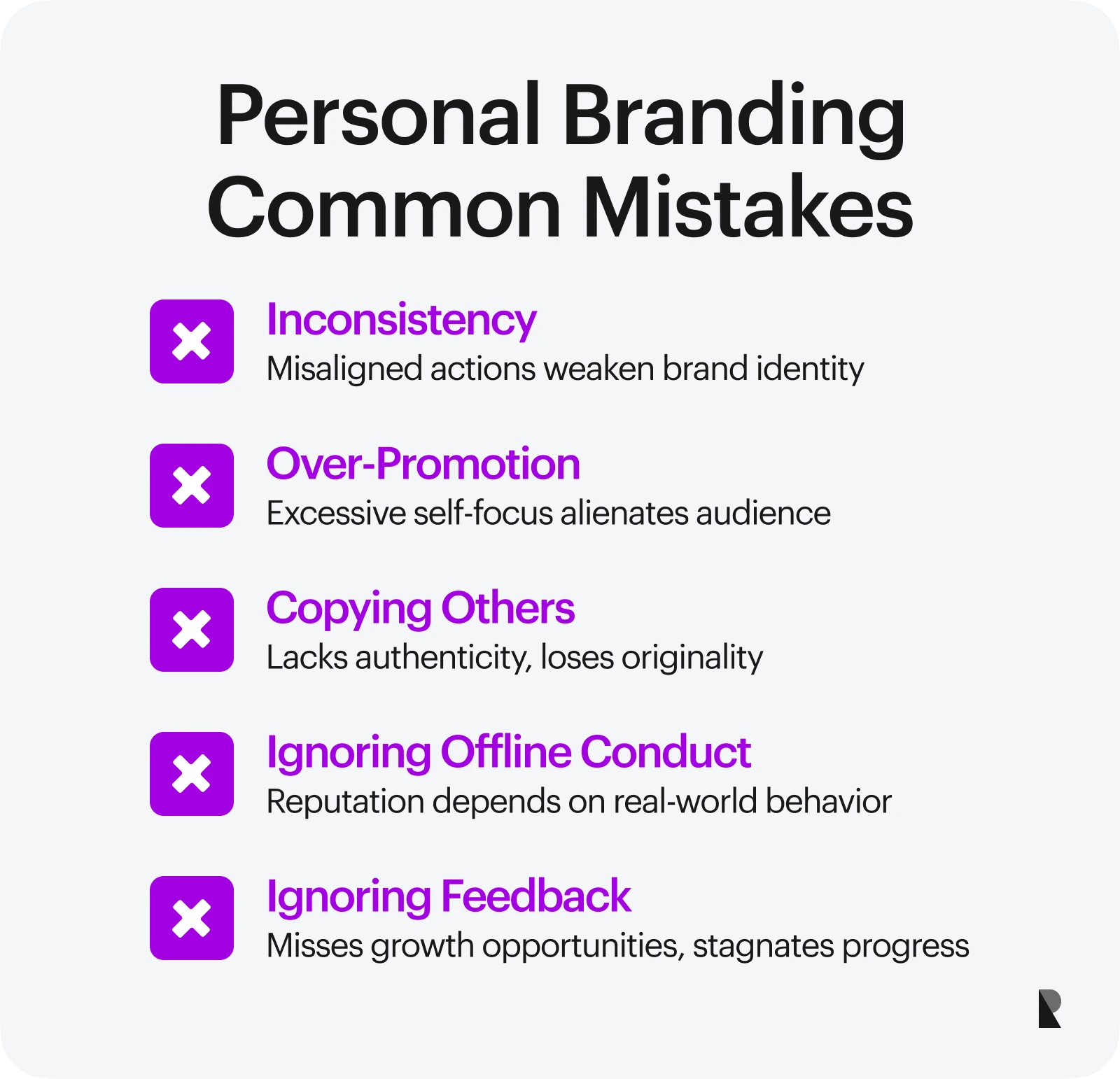
Building strong personal branding is an ongoing process that faces serious obstacles as the digital landscape and audience preferences constantly change, generating new trends and mainstreams. Here are some common mistakes to avoid during your execution process to maintain your progress and move forward.
Inconsistency
It may be one of the most popular faux pas that personal brands make because there are too many interaction points to handle. Without strict and clear brand identity guidelines and design agency assistance, staying aligned with your core values and mission could be almost impossible.
Excessive self-promotion
While overconfidence and bragging might bring positive outcomes in some situations, when it comes to personal branding, being too intrusive and pushy overwhelms and confuses an audience that already suffers from a highly informative landscape.
Copying others
Although they say, "Good artists copy, great artists steal," this does not work in personal branding, as people do not like copies. Everyone is up to the original product, seeking authenticity and genuineness in communication and services.
Neglecting offline behavior
Even if you build your presence solely online, you may not ignore your offline behavior. As a branded personality, you must stay true to your core values when interacting with the public.
Ignoring feedback
They might seem like criticism and attacks, but feedback is crucial for growth and proper adaptation to new realms. Do not ignore it—actively listen and filter it to derive insights for improvement.
Best Platforms to Grow Your Brand
Growing your brand online requires managing your communication across multiple interaction points, as your target audience may use different platforms for communication. Here are the most popular platforms to focus on to run your branding, marketing, and advertising campaigns:
LinkedIn is a social networking platform with millions of users. It is excellent for collaboration opportunities, building a network, finding partners, communicating with industry peers and leaders, and sharing professional updates.
X/Twitter
The father of microblogging, X (formerly known as Twitter), is one of the biggest online communities where people share their opinions, thoughts, news, and information through simple formats. It is great for quickly sharing updates and keeping your fans tuned.
Medium
Medium is a popular blogging platform where storytelling lets you connect with others. It is a great instrument for driving engagement by sharing valuable content and involving the audience through inspiring comments and feedback.
Substack
Substack is a tool for building and managing subscription-based content and monetizing interaction with the target audience. It has all the tools required to publish and deliver valuable content to readers' inboxes.
As a free photo and video-sharing app, Instagram has become one of Gen Z and Millennials' most popular social media platforms. It is perfect for global outreach, distributing diverse content, and engaging with businesses and fans.
Personal website
This oldie-but-goodie tool might not have an online community, but it is your unbreakable rock that underlies all your marketing and advertising endeavors in the digital landscape. It is an extension of your brand, perfectly aligned with your core values.
Real-Life Examples of Strong Personal Brands
Many excellent examples of personal brands serve different markets across various niches. Five prominent figures have built a massive community around their name and activities.
Elon Musk
Elon Musk is our first example. His name has become synonymous with innovation and cutting-edge technologies. Standing behind SpaceX and Tesla, he is a bold risk-taker whose ambitious decisions and direct communication style have won him a place under the Sun and created a powerful branded personality that resonates with a futuristic-oriented audience.

MrBeast (Jimmy Donaldson)
Feastables, anyone? Jimmy Donaldson (widely known as MrBeast) is one of the most significant figures in the video-sharing world and a representative example of personal branding. With almost half a billion subscribers across several generations on his YouTube channel, he is famous for his impeccable and unique audience-first approach, generosity, and consistent content style.
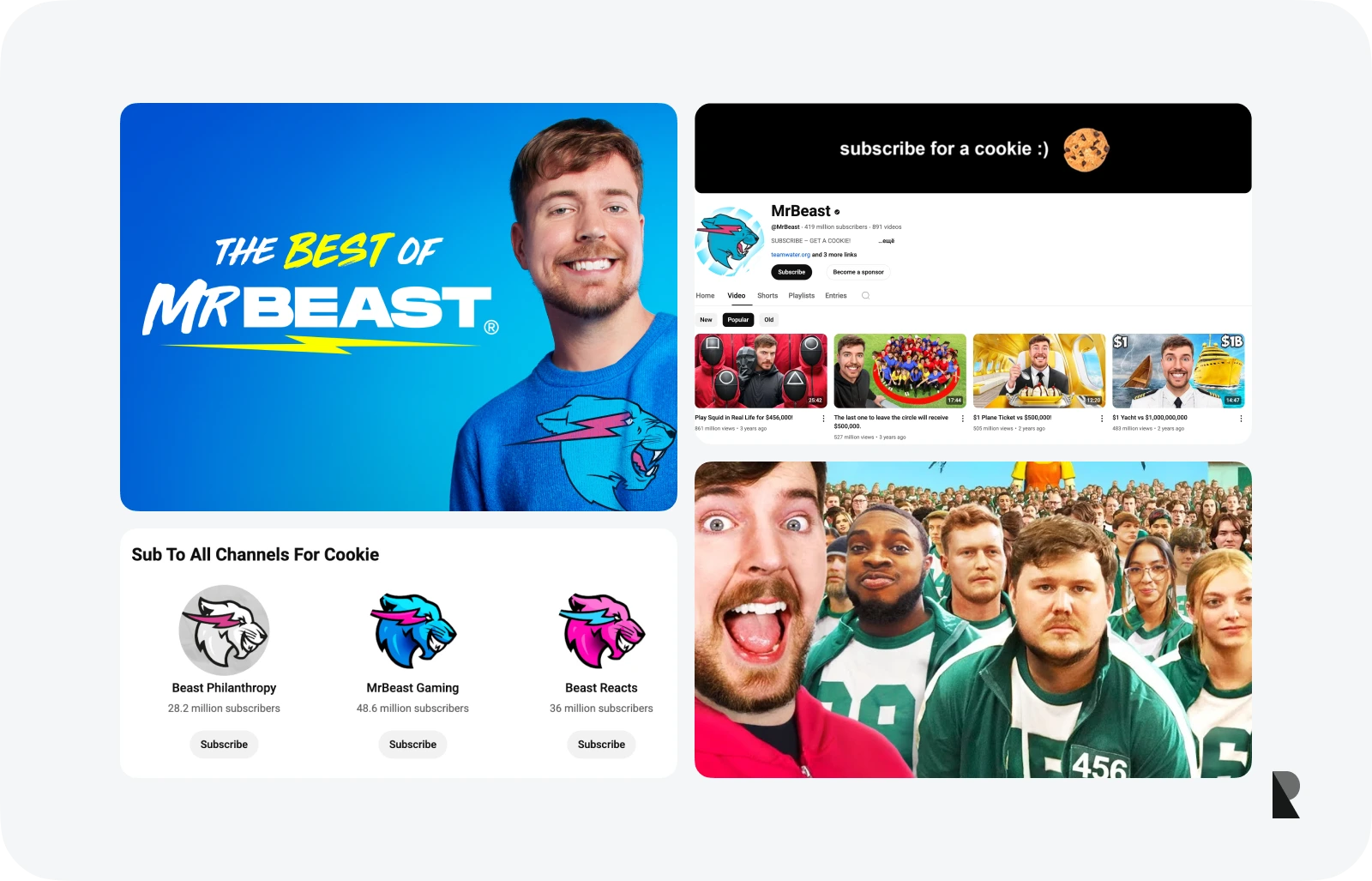
Stephen Hawking
Stephen Hawking, the former research director at the Centre for Theoretical Cosmology at the University of Cambridge, was more than just a theoretical physicist and cosmologist. He was an iconic role model for millions, immortalized in many animated series (The Simpsons) and soap operas (The Big Bang Theory). His strong personal brand is associated with clarity of message, intellectual authority, and global human connections.

Arnold Schwarzenegger
"I'll be back," or should I say, "Hasta la vista, baby?" Actor-turned-politician Arnold Schwarzenegger is one of the world's most influential figures and personal branding examples. He is famous not only for his roles in movies but also for his incredible stamina, unbreakable willpower, hardworking nature, and impeccable discipline, which shaped him into a motivational persona who inspires millions of people to go beyond limitations and never give up on their dreams.
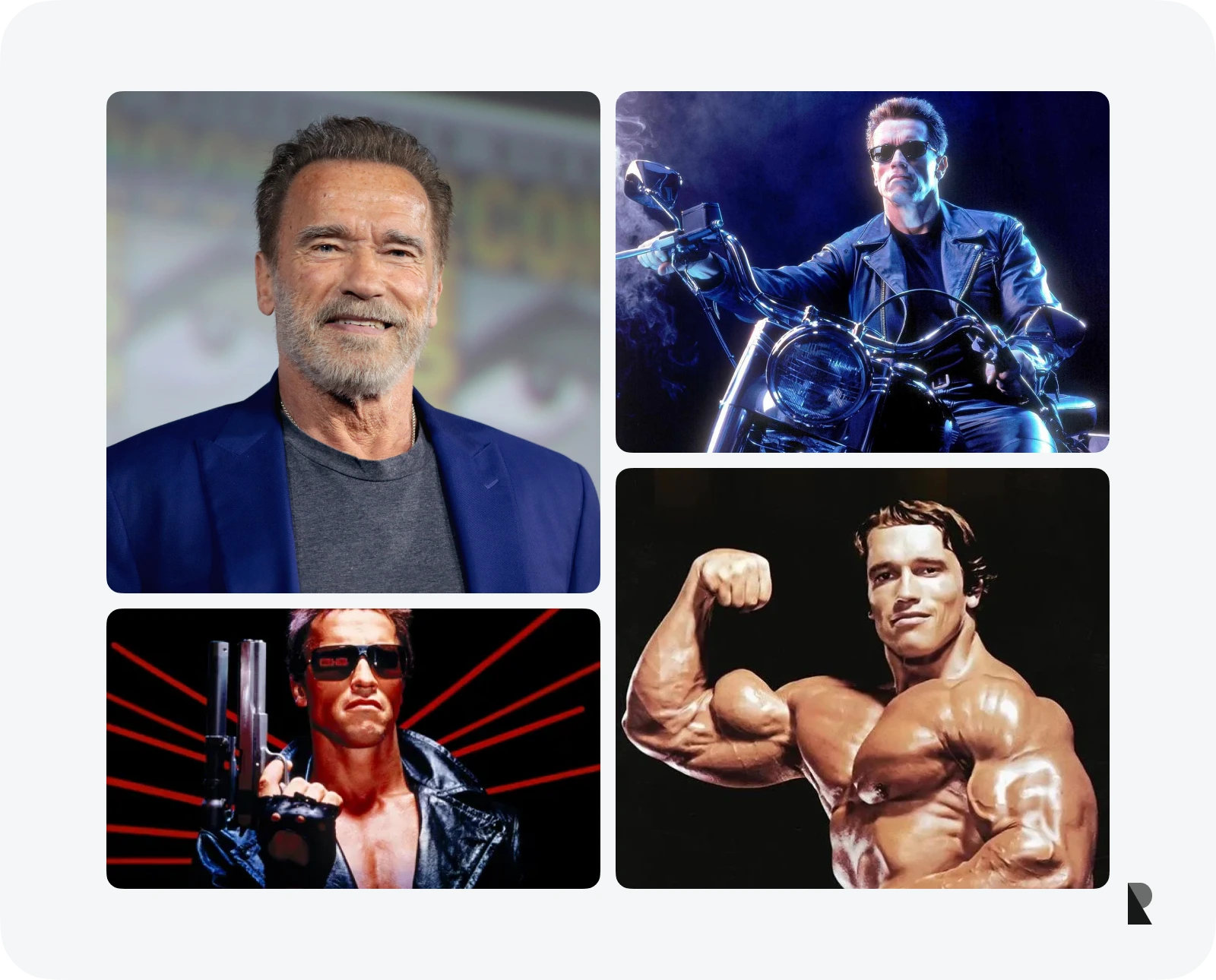
Steve Jobs
One more thing…Daring, bold, creative, and just ingenious, Steve Jobs was an icon of the technology world who revolutionized mobile communication with Steve Wozniak. His powerful personal branding was focused on innovation, perfection in design, and an engaging storytelling experience that still empowers creativity in people today.
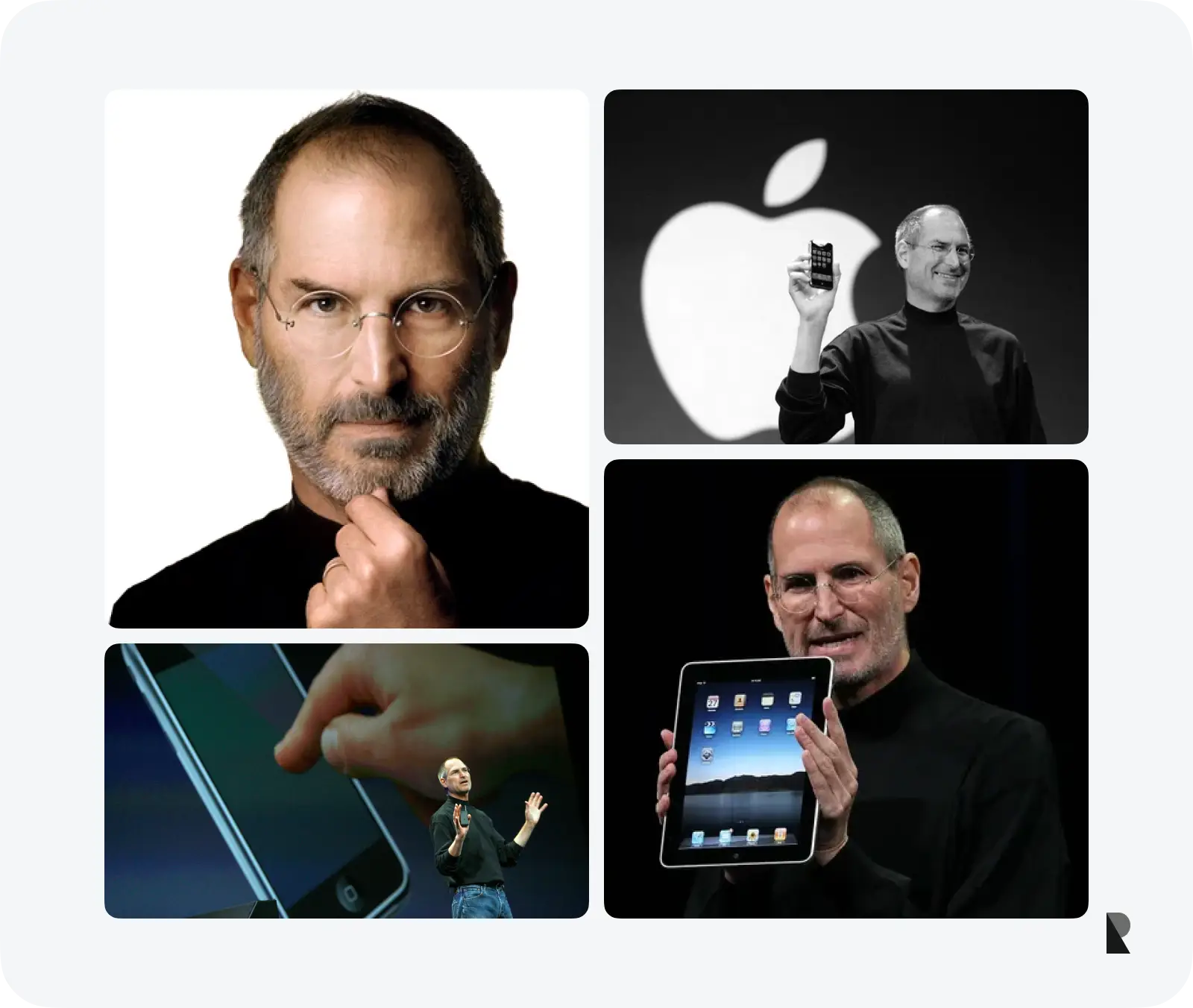
How to Measure the Impact of Your Brand?
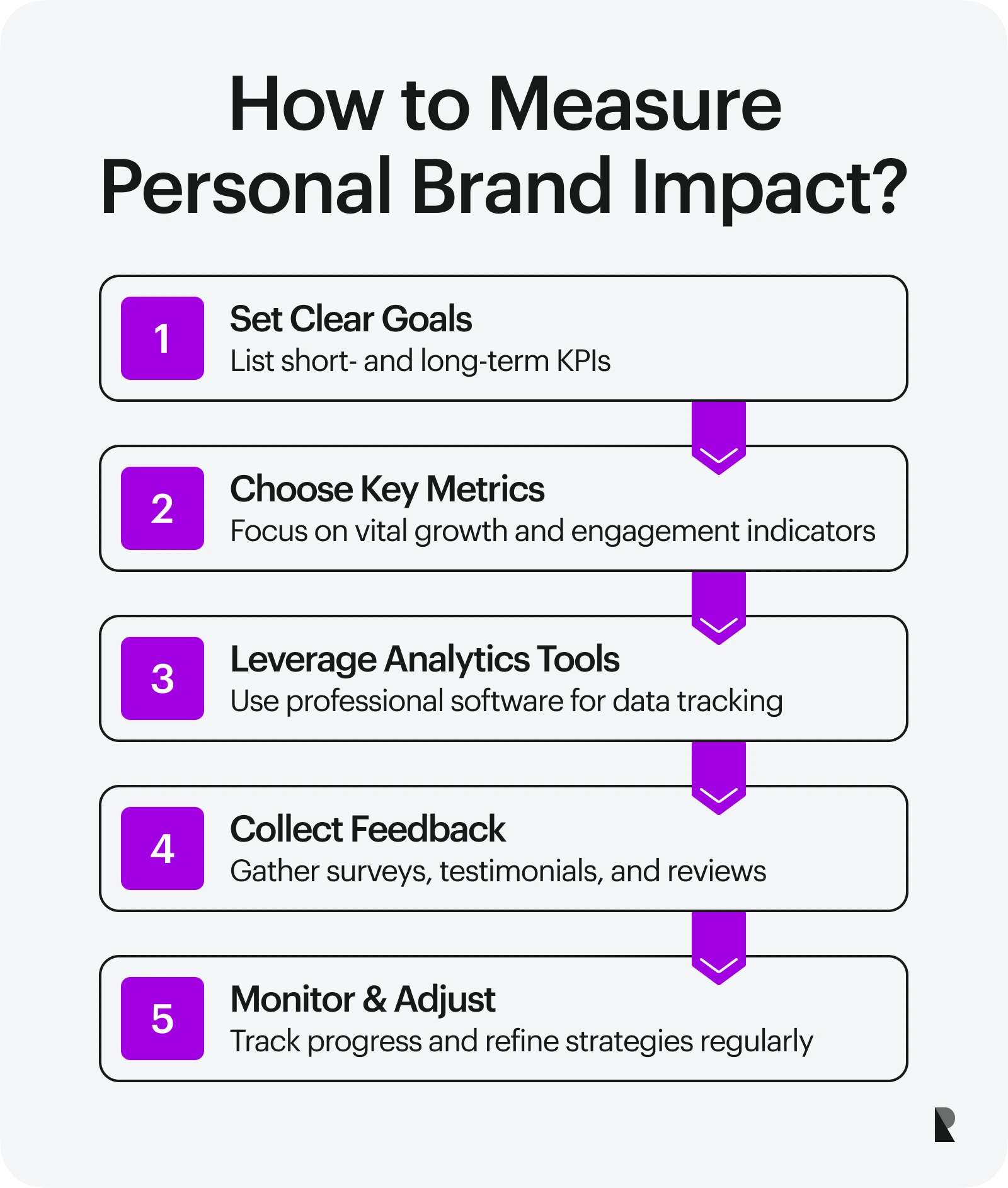
Effectively tracking and measuring the impact of your brand endeavors is crucial for getting real insight into weaknesses and areas for improvement. Here are some professional tips on how to do it during the execution stage.
Define your short—and long-term goals by listing clear and measurable KPIs. These should cover all crucial brand interaction and activity areas, including social media engagement, content shares, collaboration offers, and inbound inquiries.
Identify the right metrics to track. Do not spread your efforts thin; focus on the most vital ones, such as website traffic, subscription list growth, conversions, lead generation, job offers, and speaking opportunities.
Use professional software. As your brand grows over time, you will encounter vast amounts of data that must be processed and analyzed. Without proper instruments, this is almost impossible. Therefore, use built-in analytics and tracking tools for social media platforms, email communication, and website presence.
Gather feedback through traditional means like Google Forms or SurveyMonkey and actively seek testimonials and feedback.
Finally, track growth and adjust strategy in time, grabbing every opportunity for improvement and forwarding.
Conclusion
The importance of building a thoughtful, meaningful, memorable, and consistent personal brand is growing stronger each year as people become more concerned about the trust, authenticity, and credibility of companies, products, services, and influencers. They no longer fall for popular marketing tricks, choosing those who have earned their trust through strong reputations and a positive overall image and impression.
Creating a strong personal brand is an ongoing process that requires commitment and devotion. It also comes with its challenges. However, with a professional team, you might successfully overcome all obstacles and turn your name, vision, and mission into a viable product that contributes to community well-being and helps you achieve your professional goals.
Jul 2, 2025
